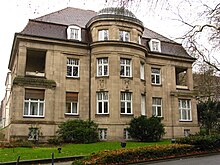Heinrich Koppers
Heinrich Koppers (born November 23, 1872 in Walbeck , † September 5, 1941 in Essen ) was a German designer , inventor and entrepreneur .
Koppers has made an outstanding contribution to fuel technology , especially coal , through his work . With his company, Heinrich Koppers AG , founded in 1901 , Koppers played a leading role worldwide in the development of coking and coal gasification technology . The entrained flow gasification according to the Koppers-Totzek process and the Shell-Koppers process goes back to him.
Live and act
Koppers originally came from farming conditions in the Lower Rhine . As a child he moved to Bochum , where his father got a job as a porter for a railway company. Koppers went to Bochum to school and completed a plumbing apprenticeship . He got his first job as a lathe operator in a rolling mill in Bochum. The ambitious Koppers was not satisfied with this simple position and attended the technical evening and Sunday school, and later the Rheinisch-Westfälische Hüttenschule , where he completed his studies in 1893.
He then started working as an operations assistant in a Munich copper works, but after a short time (in June 1894) he switched to the coking plant company Dr. C. Otto & Comp. Here he worked in the operation of the “Germania” coking plant in Dortmund and in the company's experimental coking plant in Dahlhausen , where he developed a process for obtaining cyanide from coke oven gas and improved various other processes and constructions. Finally, there was a falling out with Gustav Hilgenstock , the technical director at Dr. C. Otto & Comp. , through a radical redesign of the coke batteries from a longitudinal to a transverse regenerator. Koppers left the company, worked from March 1899 for Hugo Stinnes as head of the coking plant at Zeche Mathias Stinnes and started in 1901 finally independently to the patents , which he had signed in his time with Otto Stinnes and to further exploit and.
The superiority of Kopper's construction method quickly became apparent, and his company grew rapidly from 1904 onwards. From 1906 Koppers also received numerous orders from US Steel , so that from 1907 he worked for some time in America and in 1912 founded a subsidiary in the USA, Koppers Inc. in Chicago . He later sold the company with the associated patents to the financier and later US Treasury Secretary Andrew Mellon , under whose ownership she moved to Pittsburgh .
Heinrich Koppers died in 1941, in the middle of World War II . His company was continued by his son Hans Heinrich Koppers (1903-1967) , among others . The company later ran into financial difficulties, was taken over by Friedrich Krupp AG in 1974 ( Krupp Koppers , later ThyssenKrupp EnCoke ) and is now part of ThyssenKrupp Uhde GmbH . The US subsidiary, Koppers Inc. , still exists today, as does its diversified Chilean subsidiary, the conglomerate Sigdo Koppers .
In the Villa Koppers , Moltkeplatz 61, in Essen Moltkeviertel , the 1911-built home of Heinrich Koppers family, today the International School Ruhr located. The lobby leads into the administration building of the company H. Koppers at Moltkestraße 29 of the same year as Office and commercial building used.
literature
- Erwin Dickhoff: Essen heads. Who was what Bracht, Essen 1985, ISBN 3-87034-037-1 .
- Manfred Peter Kleinmann: Heinrich Koppers (1872–1942). In: Rheinisch-Westfälische Wirtschaftsbiographien, Volume 7. Aschendorff, Münster 1960, pp. 125–149.
- Ders .: Heinrich Koppers. Life and work. Essen [around 1971].
- Evelyn Kroker : Koppers, Heinrich. In: New German Biography (NDB). Volume 12, Duncker & Humblot, Berlin 1980, ISBN 3-428-00193-1 , p. 577 f. ( Digitized version ).
- Paul Niersmann: Heinrich Koppers. A Walbeck farmer's son who became a great inventor in coking technology. In: Geldrischer Heimatkalender , 2003 (2002), pp. 241–244.
- Georg W. Oesterdiekhoff; Hermann Strasser : Heads of the Ruhr. 200 years of industrial history and structural change in the light of biographies . Klartext Verlag , Essen 2009, ISBN 978-3-8375-0036-3 , pp. 174-177.
- LA Watson: Coke oven design - The past, the present and the future . In: The Coke Oven Managers 'Year-Book , Coke Oven Managers' Association, 2000
Web links
- Literature by and about Heinrich Koppers in the catalog of the German National Library
- Hermann Toll, History of the German Coking Companies , Essen (PDF file; 575 kB)
- The Koppers circulating current composite coke oven using the example of battery 3 at the August Thyssen coking plant
| personal data | |
|---|---|
| SURNAME | Koppers, Heinrich |
| BRIEF DESCRIPTION | German engineer and industrialist |
| DATE OF BIRTH | November 23, 1872 |
| PLACE OF BIRTH | Walbeck |
| DATE OF DEATH | September 5, 1941 |
| Place of death | unsure: food |


